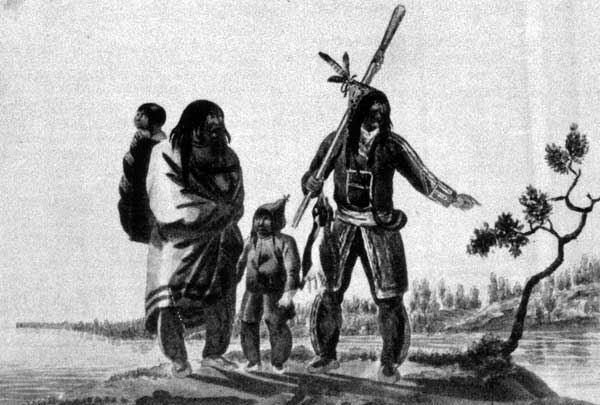by David McCrady
Winnipeg
|
Victor P. Lytwyn, Muskekowuck Athinuwick: Original People of the Great Swampy Land. Winnipeg: University of Manitoba Press, 2002. xiv, 289 pp. 9 maps, 8 charts, 9 illus., notes, bibliography, index. ISBN 0887556515,. $24.95.
Muskekowuck Athinuwick is comprehensive and interesting and clearly the work of a mature scholar. Lytwyn’s previous book, The Fur Trade of the Little North, was valuable and well received by fur-trade scholars. [1] Muskekowuck Athinuwick is an equally masterful history of the Cree people of the Hudson Bay lowlands and their involvement in the fur trade from the seventeenth through nineteenth centuries.
The opening chapter reconstructs the various social groupings among lowland Cree. Lytwyn discusses the distinction between those who lived by the coast and those who lived inland. Within these divisions, people were associated with river basins. He identifies historical groups both within the Hudson Bay Lowlands and throughout a good portion of Western Woods Cree territory.
Defining social groups and locating their usual territories from historical records would seem a simple first step when describing the Cree people of the Hudson Bay lowlands. In reality, it is a painstaking process that reflects a career of considering and evaluating sources. European recorders were often poor transcribers of Cree sounds, and the conventions they used to name local groups could differ from aboriginal ones.
The first chapter also contains good descriptions of social structure, group formation, leadership, and population. Lytwyn’s review of the records shows how European traders become inextricably linked to Aboriginal communities when they were expected to, and did, provide assistance to Native widows, orphans and the elderly.
The academic community long assumed that the Cree did not move permanently into the Lowlands until the arrival of Europeans and the trade goods that made year-round habitation possible. In the second chapter, Lytwyn argues on the basis of archaeological studies done in the 1980s and 1990s that this hypothesis is mistaken and that Cree people lived in permanent camps in the lowlands for several thousand years before the arrival of Europeans. Area specialists would have read the archaeological literature. Now, Lytwyn makes those findings readily available for the field at large and for other interested readers.

Home Guard Swampy Cree family near York Factory. Painted by the Swiss artist Peter Rindisbacher in 1821.
Source: Library and Archives Canada
Other chapters include detailed descriptions of Cree relations with other Aboriginal peoples in the eighteenth century. The Inuit, Chipewyan and Iroquois were longstanding enemies, while the Upland Cree, Northern Ojibway and Eastmain Cree were neighbours. Conflict between groups erupted for many reasons. The Iroquois, for example, hoped to disrupt the flow of trade goods from the English on Hudson Bay to the Iroquois’ enemies. Lowland Crees, on the other hand, launched raids against others in retaliation for the sorcery these others were believed to have committed against the Cree. The Cree believed enemy groups using spiritual weapons caused sickness and game shortages. Conflict was not, Lytwyn explains, over territorial expansion.
Later chapters on the Lowland Cree seasonal cycle and of their involvement in the Hudson’s Bay Company trade reflect Lytwyn’s impressive command of the Hudson’s Bay Company Archives. He provides a detailed list of the resources exploited by the Cree over the course of the year, and he identifies patterns in Cree involvement in the fur trade from the arrival of European traders in the Bay in the seventeenth century to the merger of the Hudson’s Bay and North West companies in 1821.
Lytwyn makes use of the limited published oral history of the Lowland Cree people. For the most part, Muskekowuck Athinuwick is drawn from the archives of the Hudson’s Bay
Company — so much so that the book reads, at times, less as a history of the Lowland Cree and more as a history of European views about them. On every topic, from Cree marriage patterns to goose hunting, Lytwyn delivers a series of observations made by men in charge of the various bayside posts. The Cree, themselves, stand at one remove, always the subject of someone else’s concerns and not the primary actors in their own history. The limited use of other sources means that the book remains mute on topics that European traders had less to say about.
Having said this, Muskekowuck Athinuwick remains a thoughtful and worthy contribution to the field. The Western Woods Cree in general, and the Lowland Cree in particular, remain relatively unstudied by academia. Few anthropologists have travelled among them and their oral history is only starting to be published. The Hudson’s Bay Company Archives is the most comprehensive source readily available for the study of Cree history, and Lytwyn has shown us how rich and rewarding the results can be.
1. The Fur Trade of the Little North: Indians, Pedlars, and Englishmen East of Lake Winnipeg, 1760-1821 (Winnipeg: Rupert’s Land Research Centre, 1986).
Page revised: 17 October 2012